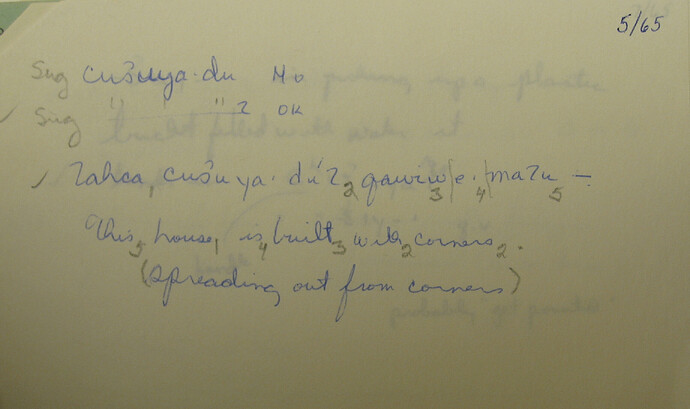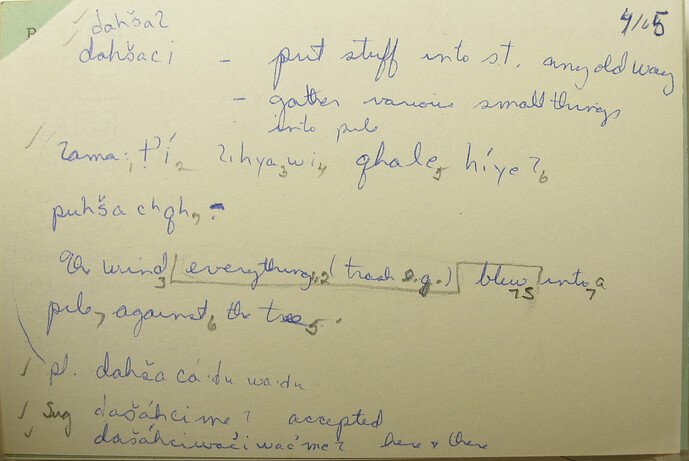I thought I would share a couple photos of some interesting old fileslips.
The language is Kashaya Pomo, and the linguist is the late Robert L. Oswalt, or RLO, as his groupies refer to him (there is at least one other such groupie here, @neilalexanderwalker!). He used an interesting glossing notation that isn’t terribly common, but is also not unique to him.
In the first card, we see RLO investigating some uses of a form cus’uya·dúʔ which means something like ‘with corners’. What’s interesting is how he glosses the sentence, using subscripts rather than vertical alignment. The advantage of that, of course, is that you only need a transcription tier and a translation tier to get a fairly robust “gloss” of each source word.
Here’s the relevant bit:
ʔahca1 cus’uya·dúʔ2 qawiw3 e·4 maʔu5
This5 house1 is4 built3 with2 corners2.
Admittedly, it’s not easy to read. But it seems easy to write. Note that the form in question, cus’uya·dúʔw2, has two corresponding forms in the translation, ‘with’ and ‘corners’, and we know that because both of those forms are subscripted with 2 in the translation.
It’s also interesting to note that RLO seems to have done this subscripting “alignment” work after having taken down the transcription and the translation, since the subscripts are written in pencil, not pen, which makes sense, since it kind of sucks to make someone wait unnecessarily, and figuring out the numbering would be a drag during the actual conversation.
There’s more, check out this one:
ʔama·1ṭ’í2 ʔihya3wi4 qhale5 híyeʔ6 puhšacʰqʰ7
The wind3 everything1,2 blew7S into7 a pile7 against6 the tree5
This one’s even trickier. Note the special subscript blew7S in the translation. What this means is that the gloss blew is glossing the suffix of the source form numbered 7, not the whole form. Of course, there is no indiciation here of where the morphological boundary is in the form puhšacʰqʰ (I believe it goes puhšacʰ-qʰ, but @neilalexanderwalker can correct me if I’m wrong!).
Personally I see a lot of advantages to this system when it comes to writing…
…on paper.
Of course, the real question is, what could we get a computer to do to help us handle this “alignment” process more efficiently? Obviously FLeX-style semi-automatic glossing is part of the picture.
By the way, this notation (sans the affix bit) actually goes back quite a ways; Wilhelm von Humboldt used it when glossing Classical Nahuatl back in the day. (See the Humboldt reference via the Lehmann reference in Wikipedia, because I’m lazy.)

